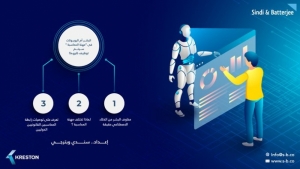عرض العناصر حسب علامة : الذكاء الاصطناعي
الإثنين, 10 أغسطس 2020 10:07
أتمتة العمليات الروبوتية RPA وسط جائحة كورونا
نشر في
تكنولوجيا المعلومات
الأربعاء, 21 سبتمبر 2022 08:22
جمعية المحاسبين القانونيين المعتمدين وبرايم جلوبال يوقعان اتفاقية للعمل معًا
وقعت جمعية المحاسبين القانونيين المعتمدين ِACCA وبرايم جلوبال Prime Global لشركات المحاسبة اتفاقية للعمل معًا في العديد من المشاريع
نشر في
موضوعات متنوعة
الأحد, 28 يونيو 2020 14:10
كيف ستؤثر شبكات 5G وWi-Fi 6 على مؤسستك؟!
نشر في
تكنولوجيا المعلومات
الثلاثاء, 16 يونيو 2020 12:49
الابتكار في التدقيق: الأمر لا يتعلق فقط بالتكنولوجيا
نشر في
موضوعات متنوعة
الثلاثاء, 14 أبريل 2020 10:30
هل تقضي الأتمتة والتكنولوجيا علي مهنة المحاسبة؟
نشر في
تكنولوجيا المعلومات
الأحد, 16 فبراير 2020 11:16
فيديو.. ندوة حول مهنة المحاسبة والذكاء الاصطناعي
نشر في
تكنولوجيا المعلومات
الإثنين, 20 فبراير 2023 10:01
خمسة طرق للأتمتة و الذكاء الإصطناعي سوف تُحوِل عمليات معالجة المصروفات و تغيرها تمامًا
مع توفر الكثير من أدوات التمويل والمحاسبة المُستنِدة إلى مجموعة النظراء، نميل إلى الإعتقاد بأن تطبيق التحول الرقمي والأتمتة في وزارة المالية قد إكتمل تقريبًا.
معلومات إضافية
-
المحتوى بالإنجليزية
With the wealth of cloud-based finance and accounting tools available, it’s tempting to think that the digital transformation of the finance department is nearly complete. But many of today’s tools simply digitize cumbersome processes and workflows — take expense management solutions as a prime example, which rely on the old paper-based expense report metaphor. Systems like these still require a huge amount of manual processing and data input, particularly from controllers and accounting teams.
Because today’s tools don’t address the underlying issues perpetuated by traditional workflows, finance teams spend far too much time chasing down missing information, aggregating data, and correcting errors instead of focusing on more strategic and impactful activities, as reported in a recent study on operational challenges for finance teams.
The next wave of technology, powered by advanced automation and AI, will completely transform the complete expense process, streamlining workflows and integrating real-time data so that finance teams only need to focus on the issues that matter most. Here’s how true transformation at every stage of the expense cycle will benefit finance teams and companies who want to achieve more.
1. Submitting Expenses
Problem: Because submitting expense reports remains such a tedious process, even with today’s best expense reporting tools, people still procrastinate until the end of the month. Key details required for compliance can get hazy by then, and finance teams devote valuable time to send reminders, track down missing information, and make accruals for unsubmitted expenses in order to close the books on time.
Solution: Software will capture, create and submit an expense automatically, significantly reducing the time an employee needs to spend on expense reports. Automation and AI can analyze a receipt photo along with the location, vendor, and other contextual details, and match it to the correct card transaction, enriching it with the required information automatically. Over time, the batch expense report will be eliminated entirely, with individual expenses being submitted for approval as they are incurred.
Payoff: Expense report filing will require far less time from employees and can become completely digital. Automatically populating fields will eliminate human error and vastly simplify the burdensome and error-prone process of coding expenses to the GL. Finance gains visibility into both submitted and unsubmitted expenses, which means they can shift the time they would normally spend tracking down receipts and estimating accruals to more strategic, high-impact activities such as spend analysis and cross-team collaboration.
2. Approving expenses
Problem: Once an employee submits a typical expense report, that report can easily get stuck waiting for the manager’s approval. And because expense reports typically bundle many different expenses into one report, managers typically don’t check line items closely. As a result, some spenders push the limits on the types of expenses they submit. If the manager does have a question about a single item, the whole report is delayed, which limits the finance team’s ability to produce accurate reports and close the books in a timely manner each month.
Solution: In a streamlined, AI-powered model, transactions can be automatically analyzed and routed in real time. Transactions that fall within the guidelines set by managers can be automatically approved and head straight to finance, while only the ones requiring attention are surfaced for manual review. AI can make intelligent decisions about where to direct individual expenses based on pre-set rules and guidelines. Over time, as more transactions are reviewed and processed, machine learning will be able to analyze patterns, predict outcomes and suggest smart policy or process changes.
Payoff: Busy managers can quickly take a look at only the transactions flagged for review instead of all transactions, speeding up the whole approval process and empowering the finance team to close the books more quickly and produce more accurate reports. Focusing attention specifically on policy deviations builds a stronger fiscal culture throughout the organization over time.
3. Auditing expenses
Problem: Managers often have to review reports from multiple employees at the last minute, and as pressure builds from the finance team to meet deadlines, managers are likely to rubber stamp approvals after just a quick scan. For this reason, most finance teams feel obliged to audit manager-reviewed expenses. Given the sheer number of reports and tight time constraints, finance often relies on shortcuts for auditing. Not surprisingly, a large number of out-of-policy expenses end up being tacitly approved. Also, even when expense reports are reviewed thoroughly, it’s difficult for humans to identify fraud through indicators like patterns of behavior over time.
Solution: Continuous, AI-powered audits will efficiently review all expenses instead of just a subset. The majority of expenses can flow directly to the general ledger, while data-driven analysis of prior individual and group spending patterns can flag anomalous transactions for manual review. Over time, machine learning will become more efficient with these tasks and help teams evolve beyond binary classifications of “in policy” or “out of policy” by identifying and learning from more complex issues. AI will also be able to benchmark normal spending patterns for specific employees, allowing policies to be customized at the individual level.
Payoff: Expect AI-powered audits to eliminate 75 percent or more of manual processing work for an organization, drastically increasing the time controllers have to do their jobs more effectively. Teams can shift their attention to high-impact issues like delinquent submissions, emerging trends, policy improvements, and cross-team coaching to communicate expectations and strengthen alignment.
4. Posting to the general ledger
Problem: Even with today’s best tools, mapping specific expenses to the right GL code is cumbersome and prone to human error. Correct, consistent GL coding is essential for accurate reporting and to ensure purchases like software and computer equipment are properly depreciated, amortized or capitalized. The problem is that employees select the expense type for a transaction during the expense reporting process, and few understand the ramifications of their choices from an accounting perspective. That can lead to some potentially comical mistakes, which are nearly impossible to identify and edit in most expense tools. Most finance teams resort to complicated hacks to fix the errors when uploading expenses to the ERP.
Solution: By using smart AI to make expense coding more intuitive (and even automatically code expenses right at the point of purchase), the need to review and fix coding can be virtually eliminated. AI can analyze purchases and flag instances when personal attention is required for accurate categorization. Over time, machine learning can accelerate speed and accuracy, as manual adjustments to coding or categorization are integrated into algorithms and patterns are identified.
Payoff: By reducing the manual effort required for posting to the GL and vastly increasing the quality and accuracy of the data, finance teams can shorten the time to close and shift their attention to analyzing trends and adjusting forecasts.
5. Reporting and analysis
Problem: Even with today’s most advanced tools, gathering useful data for reporting on travel and expense spending can be a struggle for finance teams. And as a company grows and more people submit expenses, it’s harder to put together accurate reports. Batched expense detail is aggregated in the GL without the details to identify trends and investigate anomalies. While today’s finance teams have no shortage of data, they lack the time needed to uncover the valuable insights from that data.
Solution: Unbundling expenses from batch reports into individual transactions, and using automation to instantly review them, will finally give teams the visibility they need in real time. Important patterns can be highlighted for budget owners, and managers will be able to pull the information they need directly instead of relying on the finance team to get it. By focusing on patterns, AI will be able to identify potential cost savings that would be easy to miss otherwise. As more data is analyzed, the more sophisticated these recommendations will become through machine learning.
Payoff: With accurate, real-time information freely available in one place, profit and loss owners can take more accountability for their own budgets and can make decisions proactively before it’s too late. Finance teams can illuminate high-impact savings opportunities with less manual burden.
For true transformation to take place, all of these steps need to be fully integrated so they work together, and tools must use advanced automation and AI for more than just saving time. While automation and machine learning streamline processing, AI can also analyze large amounts of data to surface meaningful insights. The payoff for teams will be increased control and visibility, more accurate and integrated data, and reporting/analytics that help to optimize company resources.
نشر في
تكنولوجيا المعلومات
الأحد, 02 فبراير 2020 09:09
تأملات نهائية حول عِقد المراجعة الداخلية
في السنوات العشر الماضية ، حدثت العديد من الأحداث المهمة التي غيرت بشكل كبير من المخاطر الذي يجب على المدققين و المراجعين الداخليين الإهتمام بها. من اللوائح الصارمة الجديدة لما بعد الأزمة المالية ، إلى إنفجارالهجمات الإلكترونية ، إلى ظهور المخاطر المتعلقة بالذكاء الإصطناعي وأخلاقيات البيانات والخصوصية ، أعاد العقد تشكيل عمل المراجعة الداخلية.
نشر في
محاسبة و مراجعة
موسومة تحت
الثلاثاء, 20 سبتمبر 2022 11:53
قائمة مهامك لنجاح شركتك في 2020
نجتهد في إنشاء عشرات من المهام المختلفة والمتميزة لوضعها في جدول التقويم الخاص بك على أمل تحفيزك لجعلك مميزاً في مجالك عن غيرك.
معلومات إضافية
- المحتوى بالإنجليزية As we’ve done each January for the past several years, we’ve created a list of a dozen tasks to put on your calendar, in hopes of encouraging you to rise above the daily grind from time to time.JanuaryTry to do a full restore from your backup. Naturally, you’re backing everything up — but are you sure it’s working? Do a test and make sure, because you don’t want to discover that your backup is faulty during a real-life emergency.FebruaryReview your cyber insurance (assuming you have some). Check with your insurance agent to find out what, exactly, is covered by your general liability policy, and then make sure you have all the extra coverage you need to cover breaches and the like under the rules of your state.MarchShare some meaningful data about the firm with your staff — something you haven’t shared before. Some suggestions: How much of your annual revenue is earned during tax season? How much more does the firm make on the average tax return than last year? What percentage of clients purchase more than one service from the firm?AprilHere’s a good one to cut down on busy season interruptions: Have all staff add NNTR (for “No need to reply”) to every group email for which there really is no need for everyone to reply.MayMarie Kondo your desk. Take an hour and an empty wastebasket and go through everything on your desk and in its drawers. The question to ask isn’t, “Does it spark joy?” but rather, “Have I used this in the last six months?” If you haven’t, throw it away. You’re not really going to need that many binder clips, and all those paper files should be digitized anyway.JuneSit down with a small group of stakeholders and describe in detail the culture you’d like your firm to have. Go beyond “We’re like a family.” Every firm is like a family. Are you the kind of family that will fire a client for being rude to an employee, or are you the kind that expects staff to serve even the most demanding clients with very high standards? Dive deep, and be specific.JulyRead a book that’s relevant to your practice. It could be about managing staff, or value pricing, or marketing professional services, or the potential impact of blockchain or artificial intelligence, or just about anything else. And if it’s good, share it with everyone in your firm.AugustCreate a will for your practice. Do you know what will happen to your clients or your staff if you get hit by a bus? Macabre as it sounds, it’s worth setting up some contingency plans.SeptemberCheck out some apps. Pick a couple of pain points — either yours or a client’s — then seek out and test some software solutions that solve for them. They don’t need to be huge issues; the idea is to get used to trying out technological solutions on a regular basis.OctoberWork from home one day a week. This will give you a sense of how well your technology is set up to support remote workers — and will show employees that you’re serious about allowing them to work remotely, too. (If you’re not set up to support remote work, that’s your alternate task for the month.)NovemberVote. That should go without saying, but even if you’re sure your preferred candidate is going to win in your state, vote anywayDecemberGo through your calendar and remove every single recurring meeting — then review each one before putting it back on. You’ll find that many have outlived their purpose, and you’ll start the New Year with a lot of extra time.
نشر في
موضوعات متنوعة
موسومة تحت
الأحد, 19 يناير 2020 10:21
البشر أم الروبوتات "فى مهنة المحاسبة" سيتم توظيف كليهما
نشر في
تكنولوجيا المعلومات
موسومة تحت










